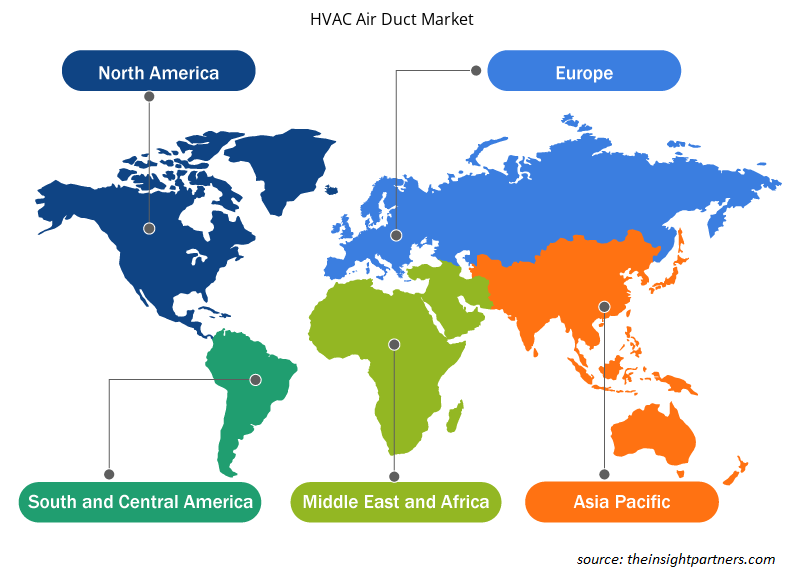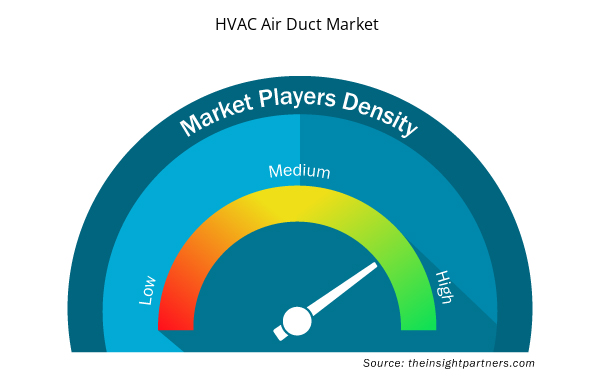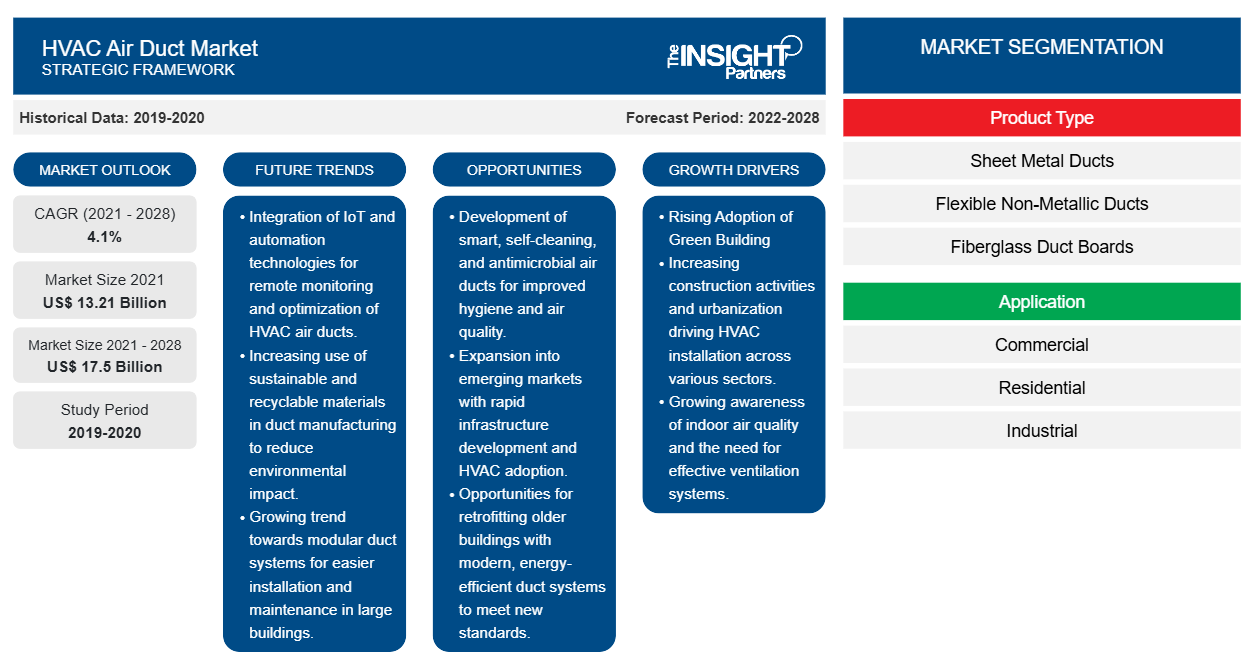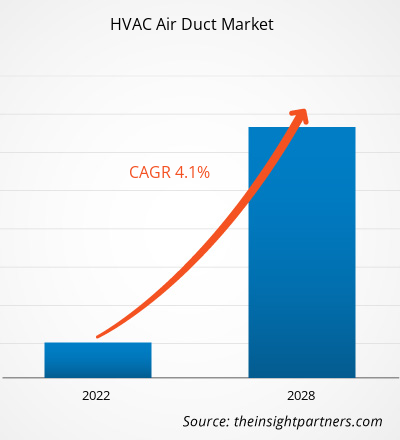El mercado de conductos de aire HVAC se valoró en US$ 13.213,7 millones en 2021 y se proyecta que alcance los US$ 17.502,6 millones en 2028; se espera que crezca a una CAGR del 4,1% entre 2021 y 2028.
La creciente inclinación hacia la tecnología de construcción ecológica y el creciente número de centros de datos están impulsando el crecimiento del mercado de conductos de aire HVAC. Los edificios ecológicos ofrecen muchos beneficios económicos o financieros, que son relevantes para una variedad de personas o grupos de personas diferentes. Con la creciente adopción de edificios ecológicos en países como EE. UU., Canadá, Alemania, Reino Unido, China y otros, la demanda de sistemas avanzados de HVAC está aumentando. Muchos arquitectos y gobiernos del sector residencial y comercial implementan tecnología de edificios ecológicos debido a sus diversos beneficios, como mayor eficiencia energética, menor huella de carbono y menor impacto en el medio ambiente. Este factor está catalizando la demanda de sistemas HVAC, que posteriormente está impulsando el crecimiento del mercado de conductos de aire HVAC . Además, el creciente número de centros de datos en todo el mundo está impulsando la demanda de sistemas HVAC y, posteriormente, impulsando el crecimiento del mercado de conductos de aire HVAC. Además, la creciente aplicación de bombas de calor geotérmicas (GHP) en edificios residenciales y comerciales está brindando oportunidades lucrativas para los fabricantes de conductos de aire HVAC. La tecnología se utiliza ampliamente para calefacción y refrigeración de locales, y se espera que su amplia aceptación aumente la demanda de conductos de aire HVAC en los próximos años.
Personalice este informe según sus necesidades
Obtendrá personalización en cualquier informe, sin cargo, incluidas partes de este informe o análisis a nivel de país, paquete de datos de Excel, así como también grandes ofertas y descuentos para empresas emergentes y universidades.
- Obtenga las principales tendencias clave del mercado de este informe.Esta muestra GRATUITA incluirá análisis de datos, desde tendencias del mercado hasta estimaciones y pronósticos.
Impacto de la pandemia de COVID-19 en el mercado de conductos de aire para sistemas HVAC
La pandemia de COVID-19 ha afectado a la mayoría de las empresas en todo el mundo. El crecimiento continuo en el recuento de pacientes infectados por el virus obligó a las autoridades gubernamentales de varios países a restringir los movimientos de personas, bienes y productos básicos mediante la imposición de restricciones de viaje, cierres masivos y cierres comerciales. La imposición del cierre ha dado como resultado una menor producción de productos básicos y bienes, y ha reducido la frecuencia de las ofertas de servicios. Las industrias manufactureras, automotrices, de semiconductores y electrónica, de petróleo y gas, de aviación, mineras y otras han sido testigos de una notable disminución de sus ingresos debido al cierre temporal de las operaciones. En el primer trimestre de 2020, después de la imposición del cierre nacional en la mayoría de las naciones, muchos sectores industriales se paralizaron. Los conductos de aire HVAC se utilizan ampliamente en laboratorios y en varias industrias como la farmacéutica, alimentaria, electrónica y de semiconductores, y la industria manufacturera. La demanda de conductos de aire HVAC en varias pequeñas y medianas empresas también se vio afectada negativamente.Sin embargo, una vez que la situación vuelva a la normalidad, se espera que el mercado de conductos de aire HVAC crezca notablemente en todo el mundo durante el período de pronóstico.
Perspectivas de mercado: mercado de conductos de aire para sistemas HVAC
Creciente adopción de edificios ecológicos
Con la creciente adopción de edificios ecológicos en países como Estados Unidos, Canadá, Alemania, Reino Unido, China y otros, y el uso de métodos de calefacción y refrigeración geotérmicos debido al aumento de la demanda de sistemas HVAC, los beneficios asociados con la tecnología de los edificios ecológicos, como una mayor eficiencia energética, una menor huella de carbono y un menor impacto en el medio ambiente, están atrayendo a muchos arquitectos y gobiernos del sector residencial y comercial a implementar esta tecnología. Este factor está catalizando la demanda de sistemas HVAC, lo que posteriormente está impulsando el mercado de conductos de aire HVAC. Además, los edificios ecológicos comerciales están buscando un mayor volumen de sistemas HVAC ecológicos para reducir su dependencia de los productos derivados del petróleo.
Información basada en el tipo de producto
Según el tipo de producto, el mercado de conductos de aire para sistemas de climatización se segmenta en conductos de chapa metálica, conductos flexibles no metálicos, placas de fibra de vidrio para conductos y otros. El segmento de conductos de chapa metálica tuvo la mayor participación de mercado en 2021.
Los actores que operan en el mercado de conductos de aire HVAC se centran principalmente en el desarrollo de productos avanzados y eficientes.
- En abril de 2020, DuctSox, un reconocido fabricante de sistemas de dispersión de aire y conductos de tela, produjo sistemas de conductos de tela que pueden utilizarse para carpas médicas durante la pandemia de COVID-19.
Perspectivas regionales del mercado de conductos de aire para sistemas HVAC
Los analistas de Insight Partners explicaron en detalle las tendencias y los factores regionales que influyen en el mercado de conductos de aire para sistemas HVAC durante el período de pronóstico. Esta sección también analiza los segmentos y la geografía del mercado de conductos de aire para sistemas HVAC en América del Norte, Europa, Asia Pacífico, Oriente Medio y África, y América del Sur y Central.

- Obtenga datos regionales específicos para el mercado de conductos de aire HVAC
Alcance del informe de mercado de conductos de aire para sistemas HVAC
| Atributo del informe | Detalles |
|---|---|
| Tamaño del mercado en 2021 | US$ 13,21 mil millones |
| Tamaño del mercado en 2028 | US$ 17.5 mil millones |
| CAGR global (2021-2028) | 4,1% |
| Datos históricos | 2019-2020 |
| Período de pronóstico | 2022-2028 |
| Segmentos cubiertos | Por tipo de producto
|
| Regiones y países cubiertos | América del norte
|
| Líderes del mercado y perfiles de empresas clave |
|
Densidad de actores del mercado de conductos de aire HVAC: comprensión de su impacto en la dinámica empresarial
El mercado de conductos de aire para sistemas de climatización está creciendo rápidamente, impulsado por la creciente demanda de los usuarios finales debido a factores como la evolución de las preferencias de los consumidores, los avances tecnológicos y una mayor conciencia de los beneficios del producto. A medida que aumenta la demanda, las empresas amplían sus ofertas, innovan para satisfacer las necesidades de los consumidores y aprovechan las tendencias emergentes, lo que impulsa aún más el crecimiento del mercado.
La densidad de actores del mercado se refiere a la distribución de las empresas o firmas que operan dentro de un mercado o industria en particular. Indica cuántos competidores (actores del mercado) están presentes en un espacio de mercado determinado en relación con su tamaño o valor total de mercado.
Las principales empresas que operan en el mercado de conductos de aire HVAC son:
- Fabricación de chapa metálica Tin Man, LLC
- Fabricantes de metales Hennemuth
- Waves Aircon Pvt. Limitada.
- Conducto Sox
- Lindab
Descargo de responsabilidad : Las empresas enumeradas anteriormente no están clasificadas en ningún orden particular.

- Obtenga una descripción general de los principales actores clave del mercado de conductos de aire HVAC
El mercado de conductos de aire HVAC se ha segmentado de la siguiente manera:
Mercado de conductos de aire para sistemas HVAC: por tipo de producto
- Conductos de chapa metálica
- Conductos flexibles no metálicos
- Tableros de conductos de fibra de vidrio
- Otro
Mercado de conductos de aire para sistemas HVAC: por aplicación
- Residencial
- Comercial
- Industrial
Mercado de conductos de aire para sistemas HVAC: por geografía
América del norte
- A NOSOTROS
- Canadá
- México
Europa
- Alemania
- Francia
- Reino Unido
- Rusia
- Resto de Europa
Asia Pacífico (APAC)
- Porcelana
- India
- Japón
- Corea del Sur
- Resto de APAC
Oriente Medio y África
- Sudáfrica
- Arabia del Sur
- Emiratos Árabes Unidos
- Resto de MEA
Sudamerica
- Brasil
- Argentina
- Resto de SAM
Mercado de conductos de aire para sistemas HVAC: perfiles de empresas
- FABRICACIÓN DE CHAPA METÁLICA TIN MAN, LLC
- Fabricantes de metales Hennemuth
- Waves Aircon Pvt. Limitada.
- Conducto Sox
- Lindab
- Sistemas de conductos llave en mano
- Fabricación de M&M
- Conjunto de conductos
- Conducto estadounidense
- Acero VK
- Análisis histórico (2 años), año base, pronóstico (7 años) con CAGR
- Análisis PEST y FODA
- Tamaño del mercado Valor/volumen: global, regional, nacional
- Industria y panorama competitivo
- Conjunto de datos de Excel


- Automotive Fabric Market
- Clinical Trial Supplies Market
- Underwater Connector Market
- Intradermal Injection Market
- Airline Ancillary Services Market
- Molecular Diagnostics Market
- 3D Mapping and Modelling Market
- Educational Furniture Market
- Integrated Platform Management System Market
- Transdermal Drug Delivery System Market

Report Coverage
Revenue forecast, Company Analysis, Industry landscape, Growth factors, and Trends

Segment Covered
This text is related
to segments covered.

Regional Scope
North America, Europe, Asia Pacific, Middle East & Africa, South & Central America

Country Scope
This text is related
to country scope.
Preguntas frecuentes
The growing application of Geothermal Heat Pumps (GHP) across residential and commercial buildings is providing lucrative opportunities for HVAC air ducts manufacturers. Geothermal heat pumps are gaining popularity in the market, owing to their highly efficient renewable energy technology, which provides both heating and cooling by using stable temperatures from the earth. A GHP system is a central heating or cooling system that pumps heat to or from the ground.
Green buildings offer several economic or financial benefits, which are relevant to a range of different people or groups of people. Green building (GB) constructions seeks to address housing demands of the growing populace with better qualities, energy efficiency, using recycled and recyclable materials, improve building lifespan and health of occupants. The building sector has the largest potential for significantly reducing greenhouse gas emissions compared to other major emitting sectors.
The sheet metal ducts are rigid air ducts and are available in different sizes and shapes, such as rectangular and cylindrical. Sheet metal duct is rigid in structure which gives the advantage of less risk of kinks or bends. However, the rigidity makes it less suitable for tight or tricky spaces. Sheet metal ducts are made from either galvanized steel or aluminum. Mold resistant nature of the nonporous material used in sheet metal ducts is the prominent factor driving the market growth. Also, easy to clean smooth surfaces, durability, and lightweight are the leading factors propelling the market growth. The availability of advanced ductwork designing software and fabricated sheet metal as per requirement demand for sheet metal ducts is flourishing in commercial and residential sectors. Increasing demand for HVAC systems in the commercial industry in the US is supporting the market growth.
The residential sector is among the prominent arenas to adopt HVAC systems. The demand for residential air conditioning has been consistently surging over the years, and the trend is anticipated to continue in the coming years. This is foreseen to continue to support the growth of the HVAC air ducts market. Moreover, the construction of residential (both single-family homes and apartment buildings) showcases an upward trend in the US nations. The installation of HVAC in the residential sector is among the residents' top priorities, and due to the rising construction activities, the demand for HVAC would surge. This is anticipated to boost the HVAC air ducts market from the residential sector. For instance, the US residential sector consumed ~236 billion kWh of electricity in 2020 for cooling, which is 6% of the total US electricity consumption.
The evolving technology in HVAC systems is expected to spur the demand for HVAC air ducts soon. The rising adoption of advanced technologies such as the internet of things (IoT) in HVAC systems is expected to fuel the growth of the HVAC air ducts market during the forecast period. The new HVAC technologies which use IoT are embedded with sensors, software that enables the HVAC system to exchange data with other connected devices. IoT systems are expected to improve preventative maintenance by sensing data on air quality and equipment status. The IoT technology will also bring more automation in HVAC systems by integrating their functions with other virtual assistant devices such as Alexa to change the temperature through the voice.
The Asia-Pacific HVAC air ducts market is growing due to growing industrialization, increase in disposable income of the consumers, rising demand for luxury products, and stringent government norms focusing on global warming are the factors that is expected to drive the growth of the segment. Growing construction sector in countries such as China and India, which are witnessing huge investments in the infrastructure sector, specifically for retail spaces, commercial office buildings, manufacturing facilities, metro rail lines, and expansion and construction of airports. This attribute increasing commercial construction projects along with expansion in the number of shopping complexes and retail stores will significantly fuel the demand for HVAC air ducts in the region.
Trends and growth analysis reports related to Electronics and Semiconductor : READ MORE..
The Insight Partners performs research in 4 major stages: Data Collection & Secondary Research, Primary Research, Data Analysis and Data Triangulation & Final Review.
- Data Collection and Secondary Research:
As a market research and consulting firm operating from a decade, we have published and advised several client across the globe. First step for any study will start with an assessment of currently available data and insights from existing reports. Further, historical and current market information is collected from Investor Presentations, Annual Reports, SEC Filings, etc., and other information related to company’s performance and market positioning are gathered from Paid Databases (Factiva, Hoovers, and Reuters) and various other publications available in public domain.
Several associations trade associates, technical forums, institutes, societies and organization are accessed to gain technical as well as market related insights through their publications such as research papers, blogs and press releases related to the studies are referred to get cues about the market. Further, white papers, journals, magazines, and other news articles published in last 3 years are scrutinized and analyzed to understand the current market trends.
- Primary Research:
The primarily interview analysis comprise of data obtained from industry participants interview and answers to survey questions gathered by in-house primary team.
For primary research, interviews are conducted with industry experts/CEOs/Marketing Managers/VPs/Subject Matter Experts from both demand and supply side to get a 360-degree view of the market. The primary team conducts several interviews based on the complexity of the markets to understand the various market trends and dynamics which makes research more credible and precise.
A typical research interview fulfils the following functions:
- Provides first-hand information on the market size, market trends, growth trends, competitive landscape, and outlook
- Validates and strengthens in-house secondary research findings
- Develops the analysis team’s expertise and market understanding
Primary research involves email interactions and telephone interviews for each market, category, segment, and sub-segment across geographies. The participants who typically take part in such a process include, but are not limited to:
- Industry participants: VPs, business development managers, market intelligence managers and national sales managers
- Outside experts: Valuation experts, research analysts and key opinion leaders specializing in the electronics and semiconductor industry.
Below is the breakup of our primary respondents by company, designation, and region:

Once we receive the confirmation from primary research sources or primary respondents, we finalize the base year market estimation and forecast the data as per the macroeconomic and microeconomic factors assessed during data collection.
- Data Analysis:
Once data is validated through both secondary as well as primary respondents, we finalize the market estimations by hypothesis formulation and factor analysis at regional and country level.
- Macro-Economic Factor Analysis:
We analyse macroeconomic indicators such the gross domestic product (GDP), increase in the demand for goods and services across industries, technological advancement, regional economic growth, governmental policies, the influence of COVID-19, PEST analysis, and other aspects. This analysis aids in setting benchmarks for various nations/regions and approximating market splits. Additionally, the general trend of the aforementioned components aid in determining the market's development possibilities.
- Country Level Data:
Various factors that are especially aligned to the country are taken into account to determine the market size for a certain area and country, including the presence of vendors, such as headquarters and offices, the country's GDP, demand patterns, and industry growth. To comprehend the market dynamics for the nation, a number of growth variables, inhibitors, application areas, and current market trends are researched. The aforementioned elements aid in determining the country's overall market's growth potential.
- Company Profile:
The “Table of Contents” is formulated by listing and analyzing more than 25 - 30 companies operating in the market ecosystem across geographies. However, we profile only 10 companies as a standard practice in our syndicate reports. These 10 companies comprise leading, emerging, and regional players. Nonetheless, our analysis is not restricted to the 10 listed companies, we also analyze other companies present in the market to develop a holistic view and understand the prevailing trends. The “Company Profiles” section in the report covers key facts, business description, products & services, financial information, SWOT analysis, and key developments. The financial information presented is extracted from the annual reports and official documents of the publicly listed companies. Upon collecting the information for the sections of respective companies, we verify them via various primary sources and then compile the data in respective company profiles. The company level information helps us in deriving the base number as well as in forecasting the market size.
- Developing Base Number:
Aggregation of sales statistics (2020-2022) and macro-economic factor, and other secondary and primary research insights are utilized to arrive at base number and related market shares for 2022. The data gaps are identified in this step and relevant market data is analyzed, collected from paid primary interviews or databases. On finalizing the base year market size, forecasts are developed on the basis of macro-economic, industry and market growth factors and company level analysis.
- Data Triangulation and Final Review:
The market findings and base year market size calculations are validated from supply as well as demand side. Demand side validations are based on macro-economic factor analysis and benchmarks for respective regions and countries. In case of supply side validations, revenues of major companies are estimated (in case not available) based on industry benchmark, approximate number of employees, product portfolio, and primary interviews revenues are gathered. Further revenue from target product/service segment is assessed to avoid overshooting of market statistics. In case of heavy deviations between supply and demand side values, all thes steps are repeated to achieve synchronization.
We follow an iterative model, wherein we share our research findings with Subject Matter Experts (SME’s) and Key Opinion Leaders (KOLs) until consensus view of the market is not formulated – this model negates any drastic deviation in the opinions of experts. Only validated and universally acceptable research findings are quoted in our reports.
We have important check points that we use to validate our research findings – which we call – data triangulation, where we validate the information, we generate from secondary sources with primary interviews and then we re-validate with our internal data bases and Subject matter experts. This comprehensive model enables us to deliver high quality, reliable data in shortest possible time.


 Obtenga una muestra gratuita de este informe
Obtenga una muestra gratuita de este informe